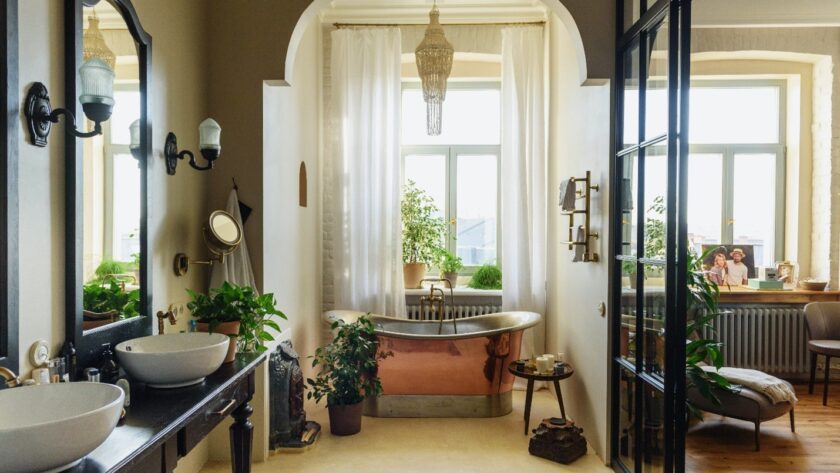With climate change and resource depletion threatening our planet, sustainable living at home matters more than ever. Your bathroom remodel presents a prime opportunity to reduce your environmental impact through eco-conscious upgrades. Beyond benefiting the planet, green materials and efficient fixtures also lower utility bills.
The cost of a bathroom remodel also depends upon the location. For example, the average cost of bathroom remodeling in Corpus Christi is $9,409, but it’s important to note that sustainability doesn’t always come with a hefty price tag. You can integrate the below-mentioned eco-friendly practices into your renovation project, whether you’re on a tight budget or have more financial flexibility. The cumulative effect of several sustainable upgrades reduces your bathroom’s carbon footprint exponentially.
1. Low-Flow Plumbing Fixtures
The first stop on your sustainability journey is upgrading to low-flow plumbing. Showers, sinks, and toilets account for over half of indoor water use. New WaterSense labeled models use at least 20% less water than standard options without sacrificing performance.
Low-flow showerheads restrict water volume while maintaining spray pressure through aerating nozzles. For sinks, aerators reduce faucet output while retaining usefulness. Dual-flush toilets offer light flushes for liquid waste and fuller flushes for solids, optimizing water use.
When embarking on a bathroom remodel in Corpus Christi, it’s essential to consider incorporating these water-saving fixtures. Consult with a Corpus Christi bathroom remodeling company to explore sustainable options and ensure that your renovation not only enhances the aesthetics of your space but also contributes to water conservation in this coastal city.
2. Energy Efficient Lighting
The right lighting slashes energy consumption while brightening your space. Swapping outdated bulbs for LEDs saves 75% on lighting costs. LEDs last 25 times longer than incandescent, reducing waste. Quality LEDs now come in any shape and hue, retaining aesthetic flexibility.
Install daylight sensors on fixtures to automatically turn off lights when sufficient natural light is available through windows or skylights. Dimmer switches also reduce energy usage and give adjustable ambiance control.
3. Water-Saving Appliances
When remodeling, pick energy-efficient washers, dryers, and dishwashers boasting eco-friendly certifications. Compare EnergyGuide labels to choose appliances with lower estimated yearly energy use.
Front-loading washers use less water than top-loaders. ENERGY STAR-certified dryers have sensors stopping operation when clothes are dry, cutting energy waste. Look for dishwashers meeting ENERGY STAR or CEE Tier 3 ratings for the best water and electricity savings.
4. Green Materials
Sustainable materials offer durability and beauty with less environmental impact. Look for tiles, sinks, counters, and other finishes made from recycled content. Renewable and common materials like stone, bamboo, and wood align with green principles. Natural linoleum, cork, and concrete make eco-friendly flooring options too.
Seeking out low-VOC, non-toxic varieties ensure indoor air quality. Local and regional materials support suppliers in your community while reducing transport emissions. Reclaimed wood brings uniqueness. With some research, you can find green materials to fit both your style and budget.
5. High-Efficiency HVAC
Heating and cooling systems often get overlooked but play a big role in home energy efficiency. Upgrading to ENERGY STAR-certified HVAC equipment cuts heating and cooling costs by up to 30%, adding up to huge savings.
Modern systems utilize improved insulation, multi-stage operation, and smarter thermostat optimization to prevent energy waste. Heat pumps offer inexpensive electric heating and cooling from one unit.
6. Waste Reduction Strategies
Minimizing waste during your bathroom remodel is another crucial aspect of sustainability. When you embark on the renovation journey, consider ways to reduce, reuse, and recycle materials. Start by carefully planning your project to avoid over-purchasing and generating excess waste. Donate or repurpose items you remove from the bathroom instead of sending them to the landfill. Salvage usable fixtures, cabinets, or tiles and incorporate them into your new design.
Additionally, look for eco-friendly disposal options for any materials that can’t be reused. Some communities have recycling programs for construction waste, and you can explore whether your old fixtures, tiles, or countertops can be repurposed by other individuals or organizations.
7. Smart Home Technology
Smart home innovations promote sustainability through automation. Programmable and occupancy-sensing thermostats tailor heating and cooling to your living patterns. Automated flushometers and faucets turn the water on and off as needed. Apps give remote system control.
Leak detection sensors prevent catastrophic water damage from burst pipes or overflowing fixtures. Smart lighting eliminates waste by turning it off when not needed. Look for technology to enhance conservation while simplifying life.
8. Renewable Energy
On-site renewable power generation lightens your utility loads. Rooftop solar panels supply your bathroom’s electricity needs through free and limitless sunshine. Solar water heaters harness the sun’s radiant energy for hot water.
Geothermal HVAC uses underground warmth and cooling for radically efficient climate control. While requiring some upfront investment, renewable systems slash energy costs and dependence long-term. They insulate you from utility rate hikes, too.
9. Indoor Plants
Indoor plants can really do some awesome things for air quality in your home. Certain houseplant varieties actually work to purify indoor air by absorbing toxins and increasing oxygen levels naturally. Some great options are aloe, bamboo palms, English ivy, and snake plants. The cool thing is, if you group a bunch of these purifying plants together in one room, they can filter the air almost as powerfully as a commercial system.
Not only do these indoor plants help you breathe easier by cleaning the air, but they also add beautiful, tranquil greenery and life to your space. Just be sure not to overwater your indoor garden.
10. Repurposed and Multifunctional Furnishings
Give discarded items renewed purpose through creative repurposing. Refinished wood furniture and antique decor save items from landfills. Upcycled containers become charming planters.
Floating shelves, slide-out cabinet organizers, and under-sink hampers maximize space efficiency. Look for multipurpose furniture like a stool that doubles as a shower seat or vanity pairing with a towel warmer. Dual-use items conserve resources intelligently.
Conclusion
With some forethought, you can implement dozens of upgrades, adding up to real sustainability. Smarter plumbing and lighting make the greatest reductions in water and electricity. Renewable power generation and high-efficiency equipment curb energy appetites. Eco-materials, plants, and repurposed furnishings add character with smaller footprints.
The collective impact of sensible solutions multiplies into tangible conservation. Take it step-by-step. You’ll enjoy an environmentally friendly sanctuary, upgrading your home’s overall sustainability.




